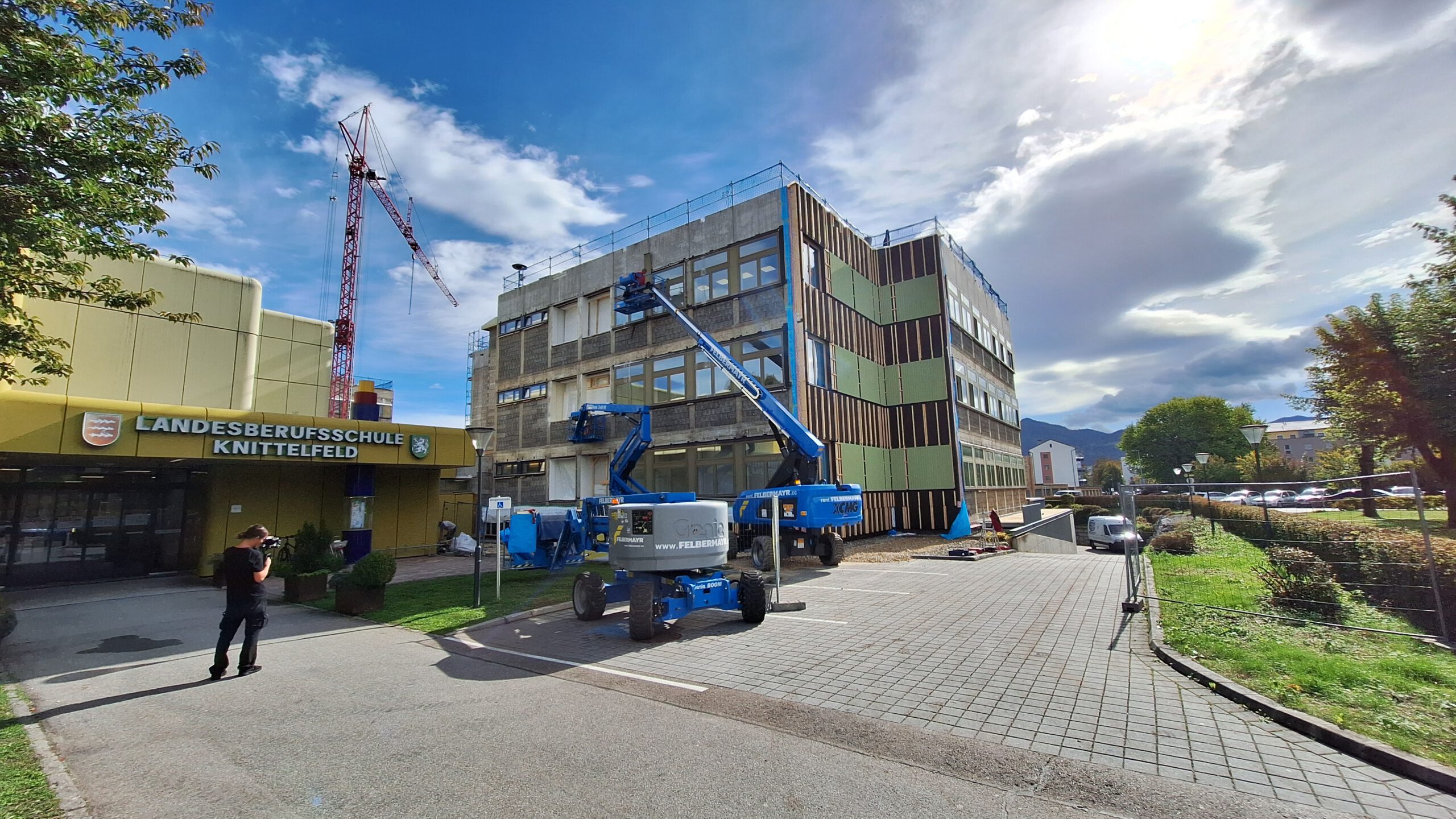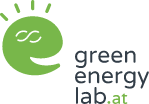Serial renovation: the modular principle for the building sector
At the Insight Talk, Green Energy Lab and AEE INTEC presented innovative concepts for serial renovation and demonstrated the enormous potential for existing buildings in Austria.

© Green Energy Lab
27 January 2025 – Austria is facing a massive wave of refurbishment: there is hardly a period in the Second Republic in which more was built than in the 1960s to 1980s. During this period, the number of buildings doubled. A veritable building boom at the time brought the typically geometric, multi-storey residential buildings to European cities in particular.
Today, 60 years later, 60 percent of the existing building stock needs to be fundamentally renovated, explains Tobias Weiss, Head of Buildings at AEE INTEC. We are therefore at the beginning of a so-called renovation wave. This is a major challenge, as there is already a refurbishment backlog that needs to be cleared. However, the time factor plays a major role in achieving the climate targets, as the building sector accounts for a whopping 35 percent of final energy demand.
In 2023, renovation activities exceeded new construction for the first time. The reasons for this include declining purchasing power, stricter lending rules and rising construction costs. It is still unclear whether this is actually a turning point or just a temporary development. In any case, sustainable renovation is just as important for climate protection as energy standards for new buildings.
The renovation market is constantly growing and holds great potential for the integration of innovative, sustainable technologies such as heat pumps, photovoltaics, solar thermal energy, the digitalisation of existing buildings and facade greening. After all, if building work is due to be carried out anyway, this is an opportunity to make the refurbishment innovative and sustainable. The upcoming wave of refurbishment therefore harbours a great opportunity to use innovative methods to bring old, inefficient buildings heated with fossil fuels up to the energy-plus standard.
All presentations as part of the Insight Talk on 21 January 2025
- Sustainable renovation – Tobias Weiss (AEE INTEC) – German only
- Best practice example “Landesberufsschule Knittelfeld” – Cornelia Ninaus (AEE INTEC) – German only
- Funding and offers for project development – Karin Dögl (Green Energy Lab) – German only
Energy savings of up to 80 percent possible
The total cost of a far-reaching decarbonisation of the building sector is estimated at around 80 billion euros. Of these costs, 60 billion euros are attributable to “regular renovations” that would be required anyway. This means that additional investments of 20 billion euros would be necessary to utilise the wave and maximise the potential for decarbonisation. Based on the unrenovated state, a comprehensive renovation could save up to 80 percent of energy. Visionary projects are already showing that bold investments in innovative refurbishment solutions are beneficial in the long term. One of these is the Green Energy Lab project RENVELOPE.
RENVELOPE process combines efficiency and innovation
Cornelia Ninaus, scientist and project manager at AEE INTEC, emphasises the advantages of serial renovations over conventional methods. This is because refurbishments are often associated with long construction times, noise and the need to relocate. Here, serial renovation offers an innovative alternative based on the modular principle. Up to 80 percent of the work steps are prefabricated in a factory hall and the modules are then delivered to the construction site by truck. This saves a lot of time and effort on site. At the same time, modern technologies such as solar thermal energy, photovoltaics, component activation and intelligent energy management sensors can be integrated directly into the modules. In conjunction with intelligent ventilation systems with heat recovery, both the indoor climate and the efficiency of the building can be significantly increased.
Don’t miss a thing: Register now for our free Green Energy Lab newsletter!
Renovation of a school building as a showcase project
One showcase project is the renovation of a vocational school run by Landesimmobiliengesellschaft Steiermark in Knittelfeld as part of the RENVELOPE project. Melanie Wölwitsch from Landesimmobiliengesellschaft (state property company) explains the objective as follows: “We must manage to fulfil our role model function and reduce the energy consumption of the buildings as sustainably and resource-efficiently as possible, improve building comfort without additional energy consumption and keep the economic burden as low as possible.”
In discussions with the regional vocational school itself, it emerged that one of the main concerns was the air conditioning in the building. From May onwards, the students are exposed to extreme heat, which makes learning in summer much more difficult. The focus here was on an innovative ventilation concept to prevent overheating due to leaky windows. Three heat pumps on the roof ensure heat recovery and maximum photovoltaic modules were also installed. The result: electricity production of 85,000 kWh per year – enough for almost 30 Austrian households. It is predicted that primary energy requirements will be reduced by 80 percent, heating requirements will be cut by 70 percent and 200 tonnes of CO₂ will be saved each year. Another advantage is that the renovation could be carried out without disrupting school operations. Lessons remained largely undisturbed, as both teachers and pupils confirm.
Another example of the successful use of “Energy Adaptive Shell” technology is a pilot project at an apartment block owned by a non-profit housing developer in Vienna. The method was adapted to demonstrate the potential of the solution in a dense, urban environment. A two-stage refurbishment model was developed in close cooperation with the social housing developer, which also includes an innovative financing model.
Gemeindebauten (municipal buildings) of the future: Wiener Wohnen sets standards
Wiener Wohnen is also focussing on serial renovation in order to significantly increase the renovation rate from the current 30 buildings per year. The aim is to carry out a comprehensive refurbishment of the 1,800 municipal buildings with 220,000 flats every 40 years. As a technical consultant at Wiener Wohnen, Georg Knirsch is particularly committed to circular planning and resource-saving construction in the context of digitalisation. He emphasises: “Looking to the future, serial facade renovation is an extremely interesting variant of thermal upgrading, as it also covers other innovative future fields.”
As the largest municipal property management company in Europe, Wiener Wohnen is breaking new ground: As part of an PPPI innovation challenge, partners were identified who could provide an overall energy concept for the serial renovation of Viennese Gemeindebauten (municipal buildings). The aim: to significantly reduce life cycle costs and construction site times. The integration of the latest digital tools (BIM), which Wiener Wohnen has been using since the end of 2024, is important here. This involves optimising the entire process of planning, constructing and managing buildings using a 3D as-built survey. The course was set during an innovation dialogue to ensure that the implementation of the innovative solutions can proceed quickly. You can find out more about the winning solutions here: https://www.ioeb-innovationsplattform.at/challenges/detail/modulares-fertigteil-system-sanierung-wiener-gemeindebauten/#challenge-200-ideas-list
In order to overcome administrative and legal obstacles, Wiener Wohnen sees great potential in alternative allocation strategies such as competitive dialogues, framework agreements and dynamic procurement systems. A pilot project is to serve as a model for extending serial renovation to several residential complexes, thereby making a significant contribution to the City of Vienna’s climate targets.
Targeted funding measures for innovative renovation
At EU level, the “Renovation Wave” strategy shows how innovative renovation is a priority. The renovation rate in the EU is set to double within 10 years. Subsidies help to cushion the additional costs of innovative renovation solutions. In Austria, Karin Doegl, expert for open innovation at Green Energy Lab, pointed out the “Leuchttürme der Wärmewende” call for proposals, which provides generous funding for innovative projects – from initial explorations to refurbishments of individual buildings and large-volume districts.
The “Leuchttürme der Wärmewende” programme will provide 180 million euros in funding for innovative renovation projects in the coming years, 35 million euros of which will be specifically for investment costs in the area of serial renovation. Funding is available for projects that implement sustainable solutions in building refurbishment and wish to define the framework for their measures.
Funds are available for exploratory projects to support the preparation of cooperative research and development projects. This includes the creation of an overall concept as well as analysing and evaluating the technical and economic feasibility. This funding is ideal for project organisers who want to further develop their concepts and put them on a solid foundation.
In addition, individual company and municipal projects can be subsidised according to the “First Come, First Serve” principle. This supports measures to improve thermal insulation and save resources in existing buildings.
There are also extensive opportunities for the renovation and construction of large-volume buildings and districts. Both stand-alone demonstration projects and those that are realised in combination with research and development measures are supported. Large-volume projects must comprise at least four residential units or 400 square metres of space, while district projects must consist of at least three buildings. New buildings are only subsidised as part of high-quality redensification projects.
Your path to subsidised implementation of innovative renovation via Green Energy Lab
Green Energy Lab specialises in supporting the implementation of innovations in funded, cooperative projects. We invite you to submit your projects with us as “Leuchttürme der Wärmewende”. Get in touch with us if you want to implement an innovative renovation concept. We will support you in the development and submission of your idea and connect you with the expertise from our network of over 350 partners from research, innovation and energy supply. Now is the time to familiarise yourself with innovative solutions so that you can quickly test them in real environments and make the benefits visible for the future.
You are currently seeing a placeholder content of YouTube. To access the actual content, click on the button below. Please note that data will be passed on to third-party providers.
Insight Talk “Sustainable renovation” (21 January 2025)
Contact
Ludwig Fliesser
Communications Manager
T: +43 676 47 19 347
E: ludwig.fliesser@greenenergylab.at
